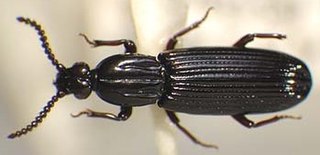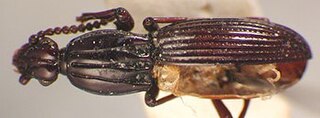Rhysodinae is a subfamily in the family Carabidae. There are 19 genera and at least 380 described species in Rhysodinae. The group of genera making up Rhysodinae had been treated as the family Rhysodidae in the past, and subsequent DNA analysis then placed it within Carabidae, where it was sometimes treated as the tribe Rhysodini, but the most recent analyses place it as a subfamily in a clade along with subfamilies Paussinae and Siagoninae, forming a sister to the remaining Carabidae.

Clinidium is a genus of wrinkled bark beetles in the subfamily Rhysodinae. Most species are Neotropical, but some occur further north in North America and there is also one species in Europe and one in Japan. Two species are known from Miocene amber.

Dhysores is a genus of beetles in the family Carabidae. It is confined to Africa.

Tangarona is a genus of wrinkled bark beetles in the family Carabidae. Tangarona pensa, found in New Zealand, is the only species of this genus.
Leoglymmius is a genus of wrinkled bark beetles in the family Carabidae. Its only species is Leoglymmius lignarius. It is endemic to Australia.

Medisores is a genus of wrinkled bark beetles in the family Carabidae. Its only species is Medisores abditus, found in South Africa. Only four specimens of this species have been found, all found dead in wood of Cassiopourea gummiflua, the onionwood tree.
Arrowina is a genus of wrinkled bark beetles in the family Carabidae. The genus occurs in Asia, with records from at least Sri Lanka, southern India, Nepal, Thailand, Sumatra (Indonesia), and Japan.

Omoglymmius is a genus of wrinkled bark beetles in the subfamily Rhysodinae, found on every continent except Africa and Antarctica. There are at least 150 species in Omoglymmius.
Plesioglymmius is a genus of wrinkled bark beetles in the family Carabidae. Specimens of this genus are rare.
Shyrodes is a genus of wrinkled bark beetles in the family Carabidae. There are at least two described species in Shyrodes.
Srimara is a genus of wrinkled bark beetles in the family Carabidae. Srimara planicollis, found in Vietnam, is the only species of this genus.
Xhosores is a genus of wrinkled bark beetles in the family Carabidae. Xhosores figuratus, found in South Africa, is the only species of this genus.
Yamatosa is a genus of wrinkled bark beetles in the family Carabidae, found in Asia.

Kaveinga is a genus of wrinkled bark beetles in the family Carabidae.

Kupeus is a genus of wrinkled bark beetles in the family Carabidae. Its only species is Kupeus arcuatus, endemic to New Zealand. K. arcuatus was originally described in 1873 by Louis Chevrolat.
Clinidium extrarium is a species of ground beetle in the subfamily Rhysodinae. It was described by R.T. & J.R. Bell in 1978. The type series originates from "N. Amerika"; the specific locality is unknown but likely was in the tropical lowlands of Mexico or northern Central America.
Rhyzodiastes denticauda is a species of ground beetle in the subfamily Rhysodinae. It was described by R.T. Bell and J.R. Bell in 1985. It is found in Sarawak.
Kaveinga poggii is a species of ground beetle in the subfamily Rhysodinae. It was described by R.T. Bell and J.R. Bell in 1985. It is known from Goodenough Island. It is named for Roberto Poggi from the Museo Civico di Storia Naturale di Genova.
Kaveinga walfordi is a species of ground beetle in the subfamily Rhysodinae. It was described by R.T. & J.R. Bell in 1992. It is found in eastern Queensland, Australia.

Ross Taylor Bell was an American entomologist with particular interest in the invertebrate natural history of Vermont, United States, and carabid beetles. Together with his wife, Joyce Bell, his work at the University of Vermont was largely taxonomic, where they described more than 75% of the rhysodine species known to science. Ross also wrote a number of seminal papers in his chosen field.







